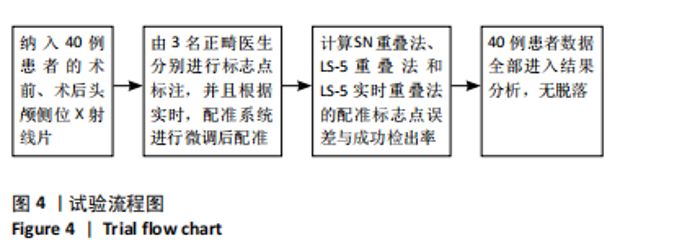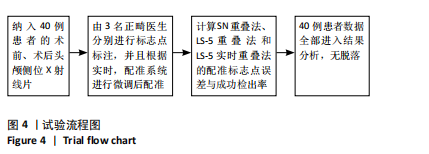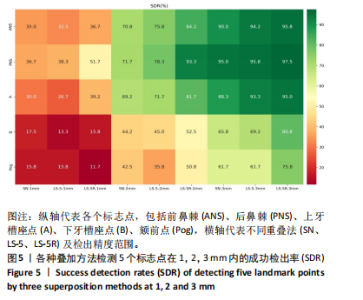Chinese Journal of Tissue Engineering Research ›› 2026, Vol. 30 ›› Issue (10): 2459-2465.doi: 10.12307/2026.624
Previous Articles Next Articles
Accuracy of a real-time registration system based on orthodontic landmarks
Huang Juneng1, Zeng Jingjie2, Peng Ying1, Lu Wenrong3, Tang Min2, Zhang Xuejun1
- 1Guangxi University, Nanning 530004, Guangxi Zhuang Autonomous Region, China; 2Guangxi Medical University Stomatological Hospital, Nanning 530021, Guangxi Zhuang Autonomous Region, China; 3First People’s Hospital of Hechi City, Hechi 547000, Guangxi Zhuang Autonomous Region, China
-
Received:2025-03-14Accepted:2025-06-18Online:2026-04-08Published:2025-08-28 -
Contact:Tang Min, MD, Chief physician, Guangxi Medical University Stomatological Hospital, Nanning 530021, Guangxi Zhuang Autonomous Region, China Co-corresponding author: Zhang Xuejun, MD, Professor, Guangxi University, Nanning 530004, Guangxi Zhuang Autonomous Region, China -
About author:Huang Juneng, MS, Guangxi University, Nanning 530004, Guangxi Zhuang Autonomous Region, China Zeng Jingjie, MS, Physician, Guangxi Medical University Stomatological Hospital, Nanning 530021, Guangxi Zhuang Autonomous Region, China Huang Juneng and Zeng Jingjie contributed equally to this work. -
Supported by:Guangxi Medical and Healthcare Appropriate Technology Development and Promotion Application Project, No. S2023094 (to TM); National Clinical Key Specialty Construction Project, No. CZ000037 (to TM)
CLC Number:
Cite this article
Huang Juneng, Zeng Jingjie, Peng Ying, Lu Wenrong, Tang Min, Zhang Xuejun. Accuracy of a real-time registration system based on orthodontic landmarks[J]. Chinese Journal of Tissue Engineering Research, 2026, 30(10): 2459-2465.
share this article
Add to citation manager EndNote|Reference Manager|ProCite|BibTeX|RefWorks
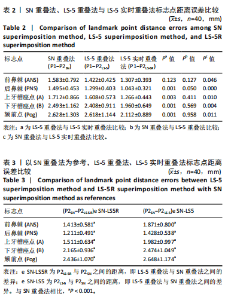
2.3 不同重叠法的结果比较 为了探索此次研究配准系统的准确性,比较了SN重叠法、LS-5重叠法与LS-5实时重叠法配准前后评价标志点的欧几里德距离。表2结果显示,3种方法中,LS-5实时重叠法标志点距离误差(e LS-5R)最小,与SN重叠法相比所有点距离误差均有显著性差异(P < 0.05),与LS-5重叠法相比PNS、A、B、Pog点的距离误差有显著性差异(P < 0.05),且差异按照PNS、A、B、Pog点的顺序依次增加。LS-5重叠法所有标志点距离误差(e LS-5)均比SN重叠法(e SN)小,但差异无显著性意义(P > 0.05)如表3所示,在3种叠加方法的比较中,对于所有的头颅标记点,两种叠加方法定位的标记之间距离小于1 mm的零假设被统计检验所拒绝;具体而言,SN重叠法与LS-5重叠法以及LS-5实时重叠法之间的临床差异均达到了统计学上的显著性水平(P < 0.001)。"
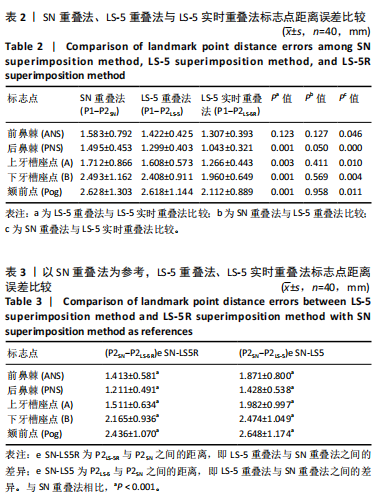
| [1] 赵志河. 口腔正畸学[M]. 7版.北京: 人民卫生出版社, 2020. [2] LENZA MA, CARVALHO AAD, LENZA EB, et al. Radiographic evaluation of orthodontic treatment by means of four different cephalometric superimposition methods. Dental Press J Orthod. 2015;20(3):29-36. [3] MOON J, HWANG H, LEE S. Evaluation of an automated superimposition method for computer-aided cephalometrics. Angle Orthod. 2020;90(3):390-396. [4] GLIDDON MJ, XIA JJ, GATENO J, et al. The accuracy of cephalometric tracing superimposition. J Oral Maxillofac Surg. 2006;64(2):194-202. [5] YOU QL, HÄGG U. A comparison of three superimposition methods. Eur J Orthod. 1999;21(6):717-725. [6] HOUSTON W, LEE RT. Accuracy of different methods of radiographic superimposition on cranial base structures. Eur J Orthod. 1985;7(2):127-135. [7] GOEL S, BANSAL M, KALRA A. A preliminary assessment of cephalometric orthodontic superimposition. Eur J Orthod. 2004;26(2):217-222. [8] BJÖRK A, SKIELLER V. Normal and abnormal growth of the mandible. A synthesis of longitudinal cephalometric implant studies over a period of 25 years. Eur J Orthod. 1983;5(1):1-46. [9] GRAF CC, DRITSAS K, GHAMRI M, et al. Reliability of cephalometric superimposition for the assessment of craniofacial changes: a systematic review. Eur J Orthod. 2022;44(5):477-490. [10] AFRAND M, LING CP, KHOSROTEHRANI S, et al. Anterior cranial-base time-related changes: A systematic review. Am J Orthod Dentofacial Orthop. 2014;146(1):21-32. [11] MELSEN B, MELSEN F. The postnatal development of the palatomaxillary region studied on human autopsy material. Am J Orthod. 1982;82(4):329-342. [12] GHAFARI J, ENGEL FE, LASTER LL. Cephalometric superimposition on the cranial base: a review and a comparison of four methods. Am J Orthod Dentofacial Orthop. 1987;91(5):403-413. [13] DANZ JC, STÖCKLI S, RANK CP. Precision and accuracy of craniofacial growth and orthodontic treatment evaluation by digital image correlation: a prospective cohort study. Front Oral Health. 2024;5:1419481. [14] SUH H, LEE H, LEE Y, et al. Predicting soft tissue changes after orthognathic surgery: the sparse partial least squares method. Angle Orthod. 2019;89(6):910-916. [15] KANG T, EO S, CHO H, et al. A sparse principal component analysis of Class III malocclusions. Angle Orthod. 2019;89(5):768-774. [16] PANCHERZ H, HANSEN K. The nasion-sella reference line in cephalometry: a methodologic study. Am J Orthod. 1984;86(5):427-434. [17] YOU QL, HÄGG U. A comparison of three superimposition methods. Eur J Orthod. 1999;21(6):717-725. [18] KIM M, MOON J, HWANG H, et al. Evaluation of an automated superimposition method based on multiple landmarks for growing patients. Angle Orthod. 2022; 92(2):226-232. [19] BAUMRIND S, FRANTZ RC. The reliability of head film measurements: 1. Landmark identification. Am J Orthod. 1971;60(2):111-127. [20] BAUMRIND S, FRANTZ RC. The reliability of head film measurements: 2. Conventional angular and linear measures. Am J Orthod. 1971;60(5):505-517. [21] TRPKOVA B, MAJOR P, PRASAD N, et al. Cephalometric landmarks identification and reproducibility: a meta analysis. Am J Orthod Dentofacial Orthop. 1997; 112(2):165-170. [22] CHEN Y, CHEN S, CHUNG-CHEN YAO J, et al. The effects of differences in landmark identification on the cephalometric measurements in traditional versus digitized cephalometry. Angle Orthod. 2004;74(2):155-161. [23] DE QUEIROZ TAVARES BORGES MESQUITA G, VIEIRA WA, VIDIGAL MTC, et al. Artificial intelligence for detecting cephalometric landmarks: a systematic review and meta-analysis. J Digit Imaging. 2023;36(3):1158-1179. [24] KIEŁCZYKOWSKI M, KAMIŃSKI K, PERKOWSKI K, et al. Application of Artificial Intelligence (AI) in a cephalometric analysis: a narrative review. Diagnostics. 2023;13(16):2640. [25] AL-TAAI N, PERSSON M, RANSJÖ M, et al. Craniofacial changes from 13 to 62 years of age. Eur J Orthod. 2022;44(5):556-565. [26] BROADBENT BH. A new x-ray technique and its application to orthodontia. Angle Orthod. 1931;1(2):45-66. [27] RICKETTS RM. A four-step metod to distinguish orthodontic changesfrom natural growth. J Clin Orthod. 1975;9:208-228. [28] ONGKOSUWITO EM, KATSAROS C, VAN’T HOF MA, et al. The reproducibility of cephalometric measurements: a comparison of analogue and digital methods. Eur J Orthod. 2002;24(6):655-665. [29] BAUMRIND S, MILLER D, MOLTHEN R. The reliability of head film measurements: 3. Tracing superimposition. Am J Orthod. 1976;70(6):617-644. [30] HUJA SS, GRUBAUGH EL, RUMMEL AM, et al. Comparison of hand-traced and computer- based cephalometric superimpositions. Angle Orthod. 2009;79(3):428-435. [31] RODEN-JOHNSON D, ENGLISH J, GALLERANO R. Comparison of hand-traced and computerized cephalograms: landmark identification, measurement, and superimposition accuracy. Am J Orthod Dentofacial Orthop. 2008;133(4):556-564. [32] COOK PA, GRAVELY JF. Tracing error with Björk’s mandibular superimposition. Angle Orthod. 1988;58(2):169-178. [33] OVARD S, LEROUX B, GREENLEE G, et al. Bias in the superimposition of lateral cephalograms in adult patients with anterior open bite. Am J Orthod Dentofacial Orthop. 2023;163(2):222-232. [34] 李东, 宋卫华. 双颌前突青少年患者拔牙矫治前后下颌骨位置分析[J]. 华西口腔医学杂志,2003,21(5):410-411. [35] HOSSEINZADEH-NIK T, EFTEKHARI A, SHAHROUDI AS, et al. Changes of the Mandible after Orthodontic Treatment with and without Extraction of Four Premolars. J Dent (Tehran). 2016;13(3):199. [36] AL NAJJAR A, COLOSI D, DAUER LT, et al. Comparison of adult and child radiation equivalent doses from 2 dental cone-beam computed tomography units. Am J Orthod Dentofacial Orthop. 2013;143(6):784-792. [37] COLCERIU-ŞIMON IM, BĂCIUŢ M, ŞTIUFIUC RI, et al. Clinical indications and radiation doses of cone beam computed tomography in orthodontics. Med Pharm Rep. 2019;92(4):346. [38] SIGNORELLI L, PATCAS R, PELTOMÄKI T, et al. Radiation dose of cone-beam computed tomography compared to conventional radiographs in orthodontics Strahlenbelastung beim digitalen Volumentomogramm im Vergleich zu konventionellen kieferorthopädischen radiologischen Unterlagen. J Orofac Orthop. 2016;77:9-15. [39] SANDHAM A. Repeatability of head posture recordings from lateral cephalometric radiographs. Br J Orthod. 1988;15(3):157-162. [40] YOON Y, KIM D, YU P, et al. Effect of head rotation on posteroanterior cephalometric radiographs. Angle Orthod. 2002;72(1):36-42. [41] COHEN AM. Uncertainty in cephalometrics. Br J Orthod. 1984;11(1):44-48. [42] HOUSTON W, MAHER RE, MCELROY D, et al. Sources of error in measurements from cephalometric radiographs. Eur J Orthod. 1986;8(3):149-151. [43] LO GIUDICE A, RONSIVALLE V, ZAPPALÀ G, et al. The evolution of the cephalometric superimposition techniques from the beginning to the digital era: a brief descriptive review. Int J Dent. 2021;2021(1):6677133. [44] SHEERAN S, HARTSFIELD JR J, OMAMI G, et al. Comparison of two 3-dimensional user-friendly voxel-based maxillary and 2-dimensional superimposition methods. Am J Orthod Dentofacial Orthop. 2023;163(1):117-125. |
| [1] | Xu Chang, Jiang Mingzhu, Liu Xin, Yan Weijun. Three-dimensional finite element analysis of implant anchorage combined with torque auxiliary arch to lower anterior teeth [J]. Chinese Journal of Tissue Engineering Research, 2026, 30(8): 1971-1978. |
| [2] | Cao Yilin, Wang Xinyu, Zhuang Yan, Wang Yaru Jiang Zhixiu, Liu Danyu, Men Jiuxu, Ding Yuansheng. Three-dimensional finite element analysis of three-dimensional printed personalized orthodontic appliances for vertical movement of single teeth [J]. Chinese Journal of Tissue Engineering Research, 2025, 29(16): 3360-3368. |
| [3] | Huang Yangyang, Wang Shiyu, Liu Hao, Yang Li, Wang Penglai, Yuan Changyong. Effect of sagittal overcorrection design on displacement and stress of mandibular anterior teeth intrusion using clear aligners [J]. Chinese Journal of Tissue Engineering Research, 2024, 28(29): 4593-4598. |
| [4] | Peng Yuanhao, Lyu Dongmei, Zhuang Xinyi, Yu Ting, Cheng Qian. Consistency between two types of cone-beam CT transformed two-dimensional images and traditional lateral cephalometric radiographs for quantitative analysis of cervical vertebral bone age [J]. Chinese Journal of Tissue Engineering Research, 2024, 28(18): 2881-2886. |
| [5] | Zhang Guorui, Zhang Kunwu, Chen Wenyuanfeng, Liu Yining, Li Duhong, Zhang Xinzhu, Cao Baocheng. Effect of different stretching lengths of lingual movable wing on the adduction of mandibular anterior teeth: a biomechanical study [J]. Chinese Journal of Tissue Engineering Research, 2024, 28(2): 247-251. |
| [6] | Liu Yafei, Wang Yalin, Zuo Yanping, Zhao Lixia, Wei Jing, Zhang Chao, Song Lei. Changes in the temporomandibular joint following maxillary protraction for skeletal class III malocclusion at different ages [J]. Chinese Journal of Tissue Engineering Research, 2023, 27(32): 5203-5208. |
| [7] | Wan Zhe, Du Jun, Hu Yang. Effects of Gushukang on transforming growth factor beta1 and beta-catenin during molar intrusion in Beagle dogs [J]. Chinese Journal of Tissue Engineering Research, 2023, 27(28): 4502-4506. |
| [8] | Wang Biqi, Zhang Miaomiao. Finite element analysis on overerupted maxillary first molar intrusion using clear aligner [J]. Chinese Journal of Tissue Engineering Research, 2023, 27(25): 4051-4056. |
| [9] | Zhang Haolin, Wang Yalin, Liu Yafei, Zuo Yanping, Zhang Xiaohuan. Effect of maxillary protraction on temporomandibular joint changes in skeletal class III children: a correlation analysis [J]. Chinese Journal of Tissue Engineering Research, 2023, 27(11): 1641-1646. |
| [10] | Zhang Min, Bai Shulin, Li Shenghong, Fan Zhibo, Xie Yijia, Xu Xiaomei. Effects of high mobility group box 1 and ERK1/2 pathway on autophagy of human periodontal ligament cells under tensile stress [J]. Chinese Journal of Tissue Engineering Research, 2023, 27(10): 1560-1566. |
| [11] | Wu Yujie, Wan Xiaofang, Wei Mianxing, Peng Shiyuan, Xu Xiaomei. Correlation between autophagy and the Hippo-YAP protein pathway in periodental ligament cells on the pressure side of a mouse model of orthodontic tooth movement [J]. Chinese Journal of Tissue Engineering Research, 2023, 27(5): 683-689. |
| [12] | Ding Xue, Jia Ying, Liu Chun, Yang Shirong, Lai Lingyan, Yang Hua, Ding Qi. Displacement and rate changes of orthodontic tooth movement in Sprague-Dawley rats with chronic fluorosis [J]. Chinese Journal of Tissue Engineering Research, 2022, 26(29): 4687-4692. |
| [13] | Liu Ke, Fan Haixia, Wang Hong, Cheng Huanzhi, Geng Haixia. Expression and significance of collagen fiber and matrix metalloproteinase-9 during orthodontic root resorption in rats [J]. Chinese Journal of Tissue Engineering Research, 2022, 26(27): 4288-4292. |
| [14] | Yang Junhui, Luo Jinli, Yuan Xiaoping. Effects of human growth hormone on proliferation and osteogenic differentiation of human periodontal ligament stem cells [J]. Chinese Journal of Tissue Engineering Research, 2021, 25(25): 3956-3961. |
| [15] | Liu Yafei, Wang Yalin, Zuo Yanping, Sun Qi, Wei Jing, Zhao Lixia. Structural changes of the temporomandibular joint in adolescents with skeletal Class III malocclusions after maxillary protraction: an X-ray measurement analysis [J]. Chinese Journal of Tissue Engineering Research, 2021, 25(8): 1154-1159. |
| Viewed | ||||||
|
Full text |
|
|||||
|
Abstract |
|
|||||
